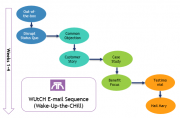E-mail replies are showing up in your in-box. They’re in your targeted accounts. Or, you mapped into your target account, found-the-right-person and are working on scheduling your initial meeting. Or you have your hands on a highly scored lead from Marketing and you are trying to follow-up. Are you stalled? Stuck? Blocked? Not advancing the … Read more
Why Predictable Prospecting over Predictable Revenue?Today it’s my turn to be interviewed by Matt Heinz of Heinz Marketing. A fast & furious 20-minute radio show where Matt & I talk about sales enablement, sales process, and how, together with our friends in Marketing, we craft compelling conversations to speed up the velocity and quality of our sales pipeline. Speed and … Read more
Avoid Bungling Your First Call With A ProspectRecently I was interviewing Tim, a busy, business development rep, as part of my assessment for a new client. Tim confided in me that his first calls were not going as well as he had hoped. Although he had names and titles of people to call, and did his research, he was not able to … Read more
15 Proven Subject Lines
Subject lines. A topic near and dear to my heart… I received an e-mail earlier this week from a consultant I follow – Ian Brodie – from the UK. Ian suggests the 15 e-mail subject lines discussed in his blog post: http://www.ianbrodie.com/best-email-subject-lines/ will increase response and open rates for your e-mail sequences (if you’re not … Read more
